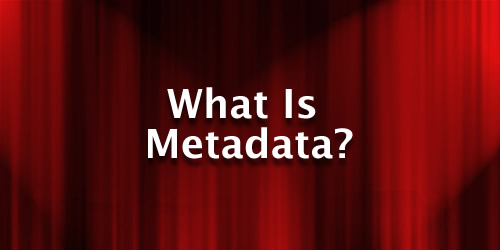
The Evolution of Metadata and Leading Opinions
Generally, under Model Rules of Professional Conduct Rule 1.6, a lawyer is prohibited from revealing any information related to the representation of a client. Either voluntarily or involuntarily, unless informed consent is given by his/her client. However, client information is often inadvertently revealed in electronic document metadata.
The term Metadata refers to “other data” that provides information about a digital documents content. For instance, an image may include such “other data” as embedded information describing how large the picture is, color depth, resolution and date of creation. Contrastingly, a text document, anything from Microsoft Word to Adobe PDF’s may contain information about the original length of the document, the originating author, creation date, or short summarizations of the documents original content, including any changes.
As attorney Jim Calloway noted,” [i]n many law firms, proposed documents are circulated among lawyers by e-mail with each adding their own comments or suggestions. These comments from other lawyers in the firm attached to the document are ultimately deleted and never meant to be communicated outside of the office. But these comments might be revealed by anyone with a copy of the document.”
The New York State Bar specifically addressed this very conceivable dilemma in its Opinion 782, which addressed inadvertent confidential data disclosures through email, opining in part that, “a lawyer must exercise reasonable care to ensure that he or she does not inadvertently disclose his or her client’s confidential information.”
Most recently, however, the American Bar Association proposed potential sanctuary’s for attorneys concerned with violating Rule 1.6 through electronic document exchanges in its Formal Opinion 06-442. Primarily, the opinion summated that, “ [a] lawyer who is concerned about the possibility of sending, producing, or providing to opposing counsel a document that contains or might contain metadata, or who wishes to take some action to reduce or remove the potentially harmful consequences of its dissemination, may be able to limit the likelihood of its transmission by ‘scrubbing’ metadata from documents or by sending a different version of the document without the embedded information.”
Since then, there have been a handful of state bar opinions suggesting that attorneys ultimately have an ethical duty to exercise reasonable care in transmitting electronic documents to ensure the nondisclosure of his/her clients confidential information. However, many attorneys are left wondering what constitutes reasonable care in scrubbing documents, how much is needed and what is good enough to absolve an attorney of liability. Next, we’ll look at popular methods proposed by many state bar associations.
How to Personally Remove MetaData From Electronic Documents.
The bottom line, you can never be too careful when transmitting electronic documentation to third parties. By following a few simple steps, an attorney can ensure that no client information is inadvertently or negligently disclosed with potentially harmful consequences, both for attorney’s and the attorney’s client.
Popular word processing programs such as Microsoft Office, Adobe Acrobat, and Word Perfect all offer internal scrubbing tools that will suffice on their own in removing potentially damaging metadata.
WordPerfect offers a short one-minute YouTube video on correctly removing metadata data for its documents. Similarly, likeminded Microsoft Office Suite users have provided quick and easy tutorials for removing metadata from both Office and Excel. The same is provided for Adobe PDF. However, If you wish to be extra thorough, there are third-party applications guaranteed to scrub your documents or your money back!
Using Third-Party Software to Remove Metadata.
There seems to be a slight consensus about preferred metadata liability sanctuaries, as noted by Cometdocs.com, on the leading third-party software tools available to scrub Microsoft documents of metadata. Cometdocs, and others suggest the following:
This tool will allow you to analyze all of your Office documents in order to discover and then delete all of the potentially harmful or even embarrassing metadata that you don’t want others to see. It is a free tool for business or personal use and is able to clean one or multiple documents at the same time.
BEC MetaReveal will scrub away any metadata that you don’t want included in your documents. You can either tell the software to get rid of all metadata in your Office document or to show you what metadata is included in the document, so that you can then selectively decide what metadata you want to keep or remove. It’s great because it is linked to Microsoft Outlook and prompts you to remove your metadata as you press the send button, making it impossible for you to forget to take a look at the metadata of an Office document before emailing it to someone.
3. iScrub 7 EP1
Not only does this tool clean your documents and manage your metadata, but it also allows you to convert your documents into PDF after you have cleaned them. There is no metadata that is safe from iScrub – it will find everything from past document author information, to tracked changes, deleted text and any other metadata that you want to keep hidden from whoever you are sending the document to via email or any other method of sharing your Office files.
Conclusion
In conclusion, there is nothing we can do about the existence of metadata. It is a necessary consequence of the convenience of creating, storing, and transmitting electronic data in our increasingly digital age. The key is to avoid sending documents containing metadata that could potentially disclose confidential information.
Law firms can reduce their exposure by sending internal documents as PDF’s instead of Word documents, or even the old fashion way of physically handing work in progress to colleagues. Furthermore, in reducing exposure to opposing counsel, one can always employ the tried and true methods of the U.S. Postal Service or facsimile.
As with any evolving legal concept only one thing is for certain, it will change. All we can do is stay on top of the latest technology in hopes of remaining one step ahead of our seemingly lethargic legal system.

